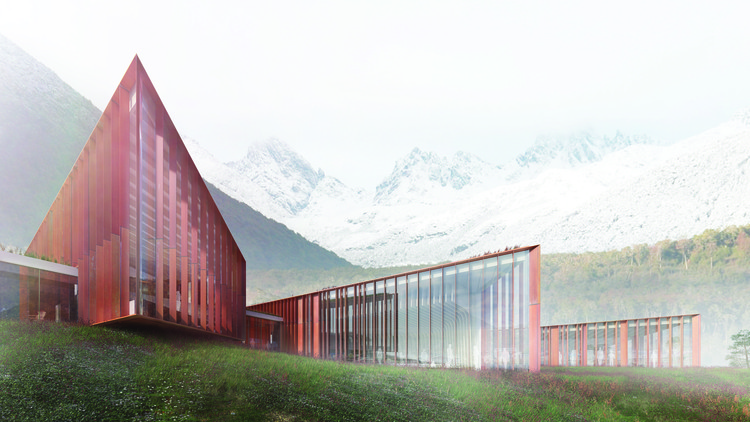
As a result of a public competition, the Chilean Regional Government has commissioned Ennead Architects to collaborate with Chilean architects Cristian Sanhueza and Cristian Ostertag on the design of the Cape Horn Sub-Antarctic Center. Planned for a site within the UNESCO Cape Horn Biosphere Reserve in Puerto Williams, a town on Navarino Island in the Chilean Sub-Antarctic Province, the center will provide a home for the Biocultural Research and Conservation Program led by Dr. Ricardo Rozzi, Professor at the University of North Texas, the Universidad de Magallanes and the Institute of Ecology and Biodiversity.

"The Center is comprised of three Sub-Antarctic Center Programs: Education, Sustainable Tourism and Sub-Antarctic Transdisciplinary Research, each housed in its own pavilion along a primary axis that is oriented for optimum solar exposure and protection from the harsh climate," described Ennead in a press release.
"The Southernmost pavilion houses the educational spaces for sustainable tourism and biocultural conservation, including classrooms, a library and study spaces. The middle pavilion contains administration offices, a multipurpose lecture hall and café, and the northernmost pavilion contains an exhibition space, research and laboratory facilities for transdisciplinary research and two apartments for visiting researchers.

"Each pavilion is connected by a continuous, transparent public hall that leverages the natural topography of the site by providing access to outdoor classroom environments and the spectacular views of the Beagle Channel, Darwin Mountain Range and Tierra del Fuego. Habitable green roofs provide living classrooms, extend the wildlife habitat potential, provide storm water management for the site and assist in the collection and storage of rainwater for re-use while passive design strategies, such as solar exposure calibration and thermal mass, create comfortable indoor environments.

"In concert with the ethos of the Cape Horn Sub-Antarctic Center, the project is designed to integrate with the local context and landscape. In reference to the red hues of the flora, existing infrastructure and maritime vessels, the Center’s design aims to capture the vivid character of the landscape while providing a sense of permanence and minimal maintenance over its life-cycle. In addition, the project aims to make the smallest environmental footprint, both in terms of natural systems on site, but also with respect to critical common resources such as electricity and potable water. The site offers great potential for renewable energy strategies that will supply the new Cape Horn Research Center as well as the greater Puerto Williams community in times of greater demand and for future resiliency."

Completion is slated for 2017.
Architects
Cristian Ostertag, Cristian Sanhueza, Ennead ArchitectsLocation
Puerto Williams, Cabo de Hornos, XII Región de Magallanes y la Antártica Chilena, ChileEnnead Design Partner
Richard OlcottEnnead Management Partner
Kevin McClurkanClient
University of Magallanes, Institute of Ecology and Biodiversity, Omora FoundationProject Year
2017Photographs
Courtesy of Ennead ArchitectsLocation
Puerto Williams, Cabo de Hornos, XII Región de Magallanes y la Antártica Chilena, ChileProject Year
2017Photographs
Courtesy of Ennead Architects













